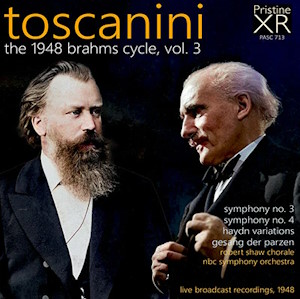
Johannes Brahms (1833-1897)
Toscanini – The 1948 Brahms Cycle Volume 3
Variations on a Theme by Haydn, Op. 56 [1873]
Symphony No. 3 in F, Op. 90 [1883]
Gesang der Parzen, Op. 89 [1882]
Symphony No. 4 in E minor, Op. 98 [1884-5]
Robert Shaw Chorale
NBC Symphony Orchestra/Arturo Toscanini
rec. November 1948, Studio 8-H, Radio City, New York
Pristine Audio PASC713 [2 CDs: 118]
Is there an echo in here? Back in 2017, I reviewed the Pristine Audio release of almost the identical program in Toscanini’s famous Philharmonia Orchestra broadcasts. Where before we got Adrian Boult’s “interval talk,”here we get Toscanini’s performance of Gesang der Parzen, which I’d not realized he’d conducted. Andrew Rose’s remasterings, as usual, elicit clarity and vivid presence; the ear quickly adjusts to the touch of grain in the strings.
Leading off, the Variations on a Theme by Haydn are more consistently realized than in the Philharmonia account: that orchestra contributed a richer sound, but Toscanini’s regular NBC players better anticipated his wishes. The conductor’s approach is forthright, with hairtrigger rhythmic address in the faster movements. Variations 2 and 5 will have you on the edge of your seat, and Variation 6 is lithe rather than hearty; yet Variation 4 is given enough time to sing, and Variation 8 is suitably shadowy. And Toscanini builds the Finale so steadily and inexorably that we’re at the piccolo-laden coda before we quite realize that we’ve gotten there.
In the F Major Symphony’s first movement, the bows sit surprisingly long on the strings, but the performance is dynamic and energized. An anomaly comes with the graceful, lilting second group, where the violins that intertwine with the liquid clarinet arpeggios seem absent or suppressed. The Andante is simple, almost brisk; at first, I wanted just a bit more breathing space, but the recap opens into a nice affirmation. The Poco allegretto sings out, but rather severely, without the Philharmonia’s dusky warmth. As before, Toscanini shapes the Finale in a broad arc, so the extended winding-down feels inevitable, but heavy-footed, evenly stressed bass pizzicatos keep the buoyant second theme earthbound.
The Gesang der Parzen goes well enough. After an introduction incisive and brooding by turns, the choral sections are starkly dramatic. The Shaw-trained singers provide excellent balance and discipline, though shortstaffed at the women’s end, with individual vibratos occasionally noticeable.
The E minor Symphony benefits from Toscanini’s “Classical” manner. Professors and commentators are apt to make a big deal out of the finale’s passacaglia, but, for the first time, I noticed similar elements in the first movement shortly after 6:00. After that, the arrival of the recap is a bit too poker-faced. Still, the taut performance received well-deserved applause. (Between movements! Horrors!)
At the start of the Andante moderato,ominous horns set a sombre, austere tone that eventually blossoms into lyricism. The scherzo erupts wtih joy, though, in the brief “B” section, the horn is oddly bashful. Toscanini plays the finale as all of a piece – in the flute variation, where many conductors slow down, he actually speeds up – reserving the rhetorical touches for the closing section.
As on the earlier issue, introductory and connecting announcements – here Ben Grauer’s – conjure a nice “you are there” immediacy. His spelling-out of “the National Broadcasting Company” and of carriage in Canada by “the Canadian Broadcasting Company” reminded me that commercial radio was still fairly newfangled in 1948.
Ideally, I’d want these Variations with the Philharmonia accounts of the symphonies – I can take or leave Gesang der Parzen. You have to make your own choices. The Pristine Classical website offers streaming; somehow, I doubt these audiophile remasterings will appear on the standard platforms!
Stephen Francis Vasta
stevedisque.wordpress.com/blog
Availability: Pristine Classical


















